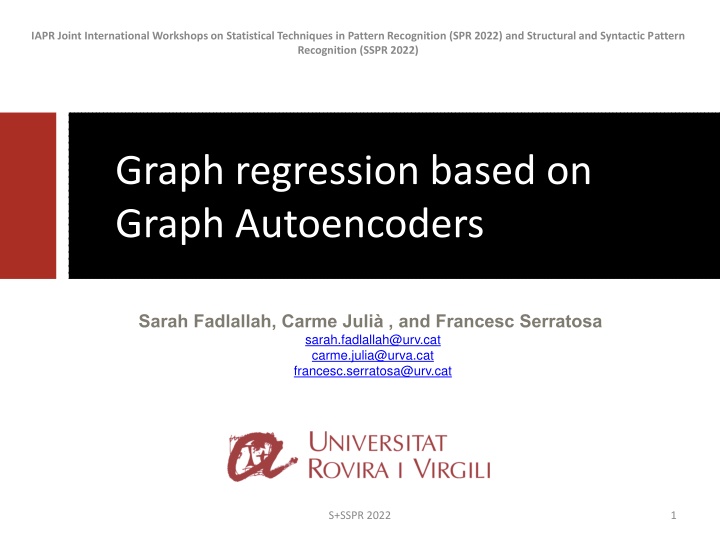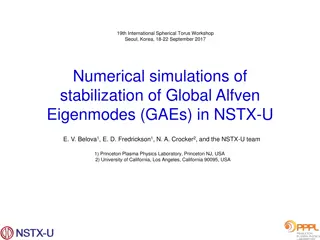
Cutting-edge Techniques in Graph Regression using Graph Autoencoders
Explore the latest advancements in graph regression using Graph Autoencoders as discussed in the IAPR Joint International Workshops on Statistical Techniques in Pattern Recognition (SPR 2022) and Structural and Syntactic Pattern Recognition (SSPR 2022). The methodology involves a 2-step approach with a Graph Autoencoder (G-AE) for embedding and learning schemes, validated with architecture configurations and results. This innovative technique showcases the significance of graphs in structured information representation, making it a valuable tool in various fields.
Download Presentation

Please find below an Image/Link to download the presentation.
The content on the website is provided AS IS for your information and personal use only. It may not be sold, licensed, or shared on other websites without obtaining consent from the author. If you encounter any issues during the download, it is possible that the publisher has removed the file from their server.
You are allowed to download the files provided on this website for personal or commercial use, subject to the condition that they are used lawfully. All files are the property of their respective owners.
The content on the website is provided AS IS for your information and personal use only. It may not be sold, licensed, or shared on other websites without obtaining consent from the author.
E N D
Presentation Transcript
IAPR Joint International Workshops on Statistical Techniques in Pattern Recognition (SPR 2022) and Structural and Syntactic Pattern Recognition (SSPR 2022) Graph regression based on Graph Autoencoders sarah.fadlallah@urv.cat carme.julia@urva.cat francesc.serratosa@urv.cat S+SSPR 2022 1
Introduction S+SSPR 2022 2
Introduction Graphs Graphs are a natural way to represent information in a structured form. Graph Proteins Nykamp DQ, Small undirected network with labeled nodes and edges. From Math Insight. http://mathinsight.org/image/small_undirected_network_labeled S+SSPR 2022 3
Basic Definitions S+SSPR 2022 4
Basic Definitions 1. Graph Convolutional Network (GCN) A graph convolutional network can take C input channels to output F features. Kipf, T.N., Welling, M.: Semi-supervised classification with graph convolutional networks. CoRR abs/1609.02907 (2016), http://arxiv.org/abs/ 1609.02907 S+SSPR 2022 5
Basic Definitions Graph Autoencoder (G-AE) Encoding input graphs and obtaining a latent vector Z Reconstructing the adjacency matrix A* The learning algorithm S+SSPR 2022 6
Methodology S+SSPR 2022 7
Methodology 2-step approach with a G-AE G-AE embedding and learning scheme S+SSPR 2022 8
Validation S+SSPR 2022 9
Validation Architecture configuration Latent space dimensions 24 x 3 Weights of the autoencoder W0: 4 x 100, W1: 100 x 3 Number of layers in neural network 1 Dataset used QM7- for energy prediction Training set 5000 graphs Training epochs 20 http://quantum-machine.org/datasets/ S+SSPR 2022 10
Validation Results (Loss and error) S+SSPR 2022 11
Validation Results (runtime) Linear regression ~5 hours Neural Network 2 minutes Linear regression ~12 hours S+SSPR 2022 12
Conclusions and Future Work S+SSPR 2022 13
Conclusions and Future Work G-AE representations were tested for regression and a NN predictions. Results were compared to Nearest Neighbour predictions. Validation showed that classical methods perform poorly in 2 aspects.. Future directions Testing on more datasets. Defining an algorithm for simultaneous learning. S+SSPR 2022 14
Thank you for your attention! S+SSPR 2022 15

